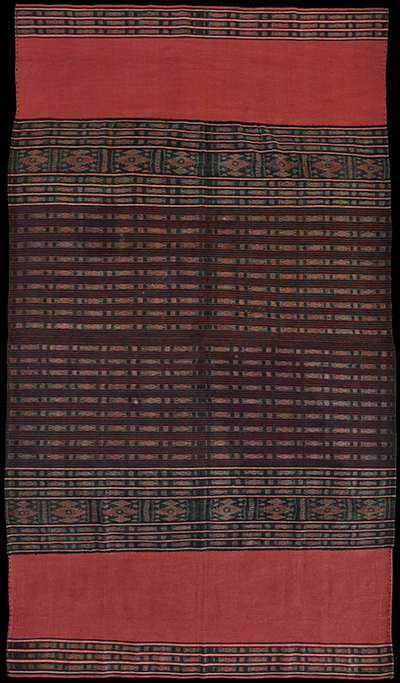| |
 
 | | | |
215 Timor, West Timor
Tais koli (shroud)  
| | Locale: | Tetun people, probably from Malaka, S.E. Western Timor; possibly from Suai Loro or Camenaça, Cova Lima district, across the border in Timor Leste. | | Period: | 1930-1945 | | Yarn: | Cotton, hand-spun, medium | | Technique: | Warp ikat | | Panels: | 4 | | Size: | 111 x 192 cm (3' 7" x 6' 3") LW: 1.73 | | Weight: | 720 g (25.4 oz), 338 g/m2 (1.11 oz/ft2) | | Design: | The overall design of this shroud, which may be used for both men and women, combines the ikated motifs that are common on Malaka and Cova Lima man's cloths, with the solid fields used in women's sarongs. Natural dyes. | | Comment: | Tetun shroud, tais koli, also known as fule mate. These shrouds, made of either 3 or 4 panels are the largest Tetun cloths, and unusual in that they are not gender-specific. It may be draped over the corpse or used to line the coffin. Tais koli are made by a daughter-in-law for the burial of her husband's parents. A household will always try to have at least one ready. Tais koli very rarely come to the market, as trading them is considered inappropriate. | | Background: | Chapters on Timor and West Timor. | | Exhibited: | Hong Kong University Museum and Art Gallery, 2017.
Timor: Totems and Tokens, Museu do Oriente, Lisbon, 2019/20. | | Published: | Ikat Textiles of the Indonesian Archipelago, 2018.Timor: Totems and Tokens, 2019.
Ikat Textiles of Timor: Indonesian and Timor-Leste, 2025. | | Sources: | Similar to a four-panel textile identified as sarong, tais feto, 'probably intended for use as shroud', in Yeager and Jacobson, Textiles of Western Timor, Plate 222, except that that newly made example is made mostly with machine made thread and chemical dyes. Similar to early 20th C. tais koli in Honolulu Museum of Art depicted in Hamilton and Barrkman, Textiles of Timor, Fig. 8.1, except that the motifs of that older example are more intricate, and that the colour of the plain bands is maroon rather than red. Overall design and some of the detail similar to early 20th C. Biboki sarong in Leigh-Theisen and Mittersakschmöller, Textilien in Indonesien. | | |

©Peter ten Hoopen, 2025
All rights reserved.
|
|


